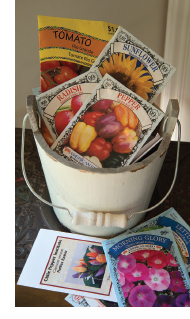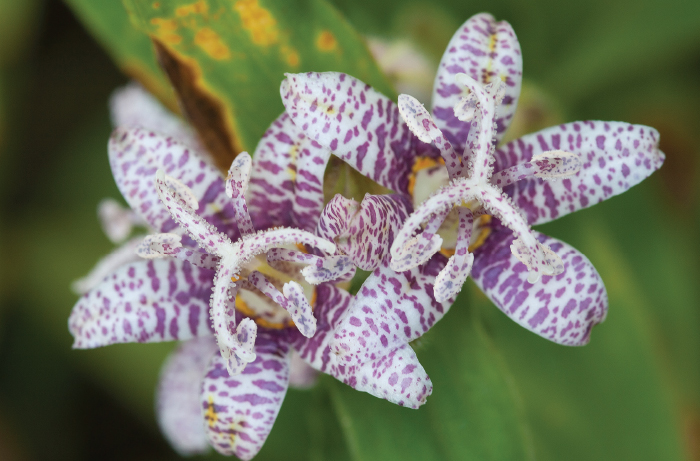Think of the word “lily,” and the vision of a colorful, sun-kissed flower with graceful arching petals probably comes to mind. Now, to this image of botanical bliss, add the word “toad,” and then feel free to scratch your head. The toad lily (Tricyrtis sp.) is indeed from the lily family, but as far as the amphibian angle goes, well, that just shows what sometimes happens when plant-namers are having an off day.
The most frequent explanation for the odd appellation “toad lily” is because this lily has spots on its blooms, much like a toad’s dots and dimples. That’s their story, and they’re stickin’ to it.
There are some 20 species of toad lilies, but the most common — meaning easiest to find at local garden centers — is Tricyrtis hirta, a herbaceous perennial that originates from Japan. Topping out at around 3 feet tall (depending on the cultivar) in the garden, this pretty plant displays graceful, arching stems showing off streaming clusters of 1-inch, skinny, exotic, orchid-like blooms that wait until early autumn to put on their dazzling shows.
Typically, the flowers are pale lilac dusted with purple specks, but because there is such a wide range of cultivars (as well as species), many interesting color variations and combinations exist.
Flustered gardeners with too many bare shady spots take note: the toad lily is a hardy woodland dweller well suited to fill such black holes in the landscape. This beauty will also look nice and play well with other plants such as hostas, Solomon’s seal, hellebores and ferns that dwell in the shadow garden.
While a toad lily might look dainty, it is certainly tough enough to thrive rather than survive in area gardens, being rated as easy to grow in Zones 4 through 8. Planted in organically rich, slightly acidic soil, the toad lily becomes a rather undemanding plant after the first year it is established. Once settled in, don’t be surprised if it starts a yearly routine of reseeding in the late fall.
Because their flowers look both bizarre and pretty at the same time, it is not unusual to see toad lilies in potted settings to bring their interesting blooms up closer to admiring eyes. They will adapt well to containers, but care must be taken to prevent them from drying out over extended periods of time. A sure sign of a toad lily stressing from dry soil is a distinct drop in bloom production.
Toad lilies are generally deer-resistant, but if rabbits frequent your garden, keep watch — these furry foragers have been known to take a liking to the foliage. Slugs can be an annoyance as well, because they occasionally gravitate to munching on the new leaves.

If you have any packets of seeds left over because you were more than optimistic about your gardening capabilities this spring, save these plants-to-be for next year’s grow-show by putting the packs in an airtight container such as a jar or sealable plastic bag and tucking them away in the refrigerator until the 2018 planting season.
As an extra touch, add a silica gel pack or teaspoon of powdered milk to the container to absorb moisture, which is a sure killer of seeds in storage.
Most year-old seeds should be fairly viable, but their germination rate might be reduced, so sow the seeds a little thicker at planting time.
To Do in the Garden
September
- While toad lilies show off in the shade, light up the full sun fall flower garden by adding the colorful snap of such hardy plants as calendula, dusty miller, ornamental kale, flowering cabbage, pansy and stock.
- Put more crunch in your family’s cuisine by starting the autumn vegetable garden with plantings of such salad-makers as broccoli, cauliflower, kale, lettuce, mustard greens, onions, radishes and spinach.
- Still harvesting and storing herbs? To speed up the process before winter sets in, herbs can be dried in the microwave. Place herbs between two paper towels and nuke ‘em for one minute. If the leaves are not crisp, microwave them for a few more seconds until the leaves feel dry to the touch. Store them in an air-tight container.
- Before leaf fall, examine your woody ornamentals for dead, diseased or damaged limbs and prune them off.
October
- If you have a small shrub or tree that is not quite in the right spot in your landscape, root prune it now to make the move much easier in late January or February.
- Have a water garden? Cover it with mesh netting to make autumn clean-up easier by keeping falling leaves out of the pond.
- Bagworms been bugging your arborvitae and juniper pride-and-joys? Insecticides are more effective when applied in the early summer. So, what can you do now? Simple — if you see any bagworm bags dangling off the branches like very ugly, brown, oblong Christmas ornaments, snip them off and toss away (do not compost).
- Nesting season is over, so clean bird houses of old nests and any other debris. However, keep the bird feeder stocked and the bird bath filled with clean water weekly for the non-migratory species that will add their kinetic colors to the fall and winter garden.







